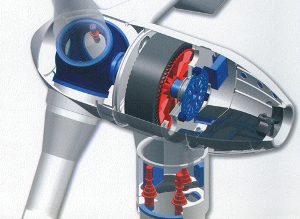
Direct drive refers to a type of wind turbine design that eliminates the gears in a conventional wind turbine. In a conventional, gear-
With a conventional generator, the gearbox dramatically increases the speed at which the generator spins so as to generate high amounts of power. With a direct drive turbine, a larger generator is used to generate the same power from a slower rotation speed.
Advantages Of Direct Drive Technology
There are three advantages to the direct drive design. One is that it increases efficiency. Some of the kinetic energy from the wind is lost in the gear box, as is always true when steps are added to energy transmission. Another advantage is that, by using permanent magnets in the generator rather than electromagnets, it’s possible to make the generator lightweight for its size, and this plus elimination of the gearbox reduces the weight of the apparatus. This is important for offshore wind power, where the weight must be supported on a floating buoy. The third advantage is that, with fewer moving parts, direct drive design is less complicated to maintain and maintenance costs are reduced over the long term. Again, this is especially important in offshore wind farming, because of the difficulty in maintaining generators at sea.
Disadvantages Of Direct Drive
The disadvantage of the direct drive design as it currently exists lies in the permanent magnets used to generate the power. Permanent magnets depend on rare earth elements for their manufacture. Rare earth elements are available primarily from China (which produces 95% of the Earth’s supply). This leaves the international community dependent on China for its continued production of wind power, with possible consequences if international relations between China and the rest of the world should worsen.
News
The push to develop renewable energy is driving investment in wind power, especially in offshore wind power farms. Since direct drive design has advantages that are especially important in offshore wind power, it’s perhaps not surprising to find that this technology is generating a fair number of headlines as well as electric power.
The European Union is investing in the development of a direct drive wind turbine that employs super conduction for increased efficiency. It’s estimated that each generator will produce as much as 10 MW of electricity under peak conditions, while reducing the size and weight of the apparatus. Without the use of super conductor technology, direct drive wind turbines typically generate 3 to 6 MW under peak conditions.
The U.S. Department of Energy (DOE) has awarded in excess of $40 million to each of seven projects for development of offshore wind power. In addition to employing direct drive design, these projects are experimenting with novel foundation designs to improve safety and security and reduce construction costs.
The federal wind power tax credit also survived the “fiscal cliff” budget deal between Congress and President Obama.
Manufacturers
At this time, the largest manufacturers of direct drive wind turbines are General Electric and Siemens, with Siemens making headlines recently for innovations in the design that may succeed in garnering increased market share. However, all major wind turbine manufacturers are moving into this technology, as it is likely to be the method of choice in large-
Prospects For The Future
Direct drive wind turbine technology promises to resolve many of the difficulties that surround offshore wind power generation. By reducing the weight of the generator assembly, increasing efficiency of power generation, and reducing maintenance costs in a maintenance-
Wind power is an important technology because it is a renewable energy source with low environmental impact. As a renewable source it is not vulnerable to resource shortages (with the possible exception of rare earth elements). Wind power also does not contribute to global warming as it results in zero greenhouse gas emissions. A mixture of wind and solar power is likely to dominate the energy picture of the future as fossil fuels become scarcer and as global warming concerns propel energy development away from burning more of what remains of them. Wind power promises to be less expensive to build than nuclear power, which is the chief non-
